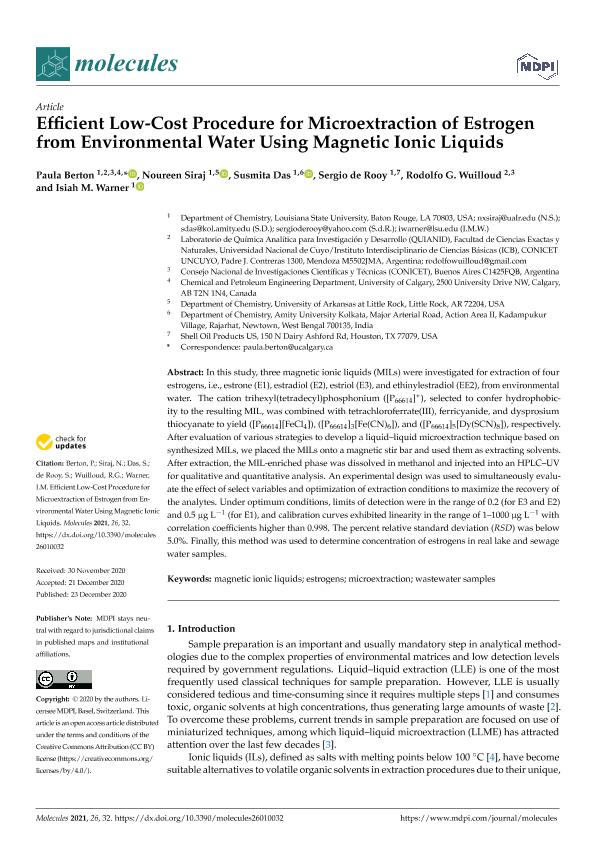Artículo
Efficient low-cost procedure for microextraction of estrogen from environmental water using magnetic ionic liquids
Berton, Paula ; Siraj, Noureen; Das, Susmita; de Rooy, Sergio; Wuilloud, Rodolfo German
; Siraj, Noureen; Das, Susmita; de Rooy, Sergio; Wuilloud, Rodolfo German ; Warner, Isiah M.
; Warner, Isiah M.
 ; Siraj, Noureen; Das, Susmita; de Rooy, Sergio; Wuilloud, Rodolfo German
; Siraj, Noureen; Das, Susmita; de Rooy, Sergio; Wuilloud, Rodolfo German ; Warner, Isiah M.
; Warner, Isiah M.
Fecha de publicación:
01/2021
Editorial:
Multidisciplinary Digital Publishing Institute
Revista:
Molecules
ISSN:
1420-3049
Idioma:
Inglés
Tipo de recurso:
Artículo publicado
Clasificación temática:
Resumen
In this study, three magnetic ionic liquids (MILs) were investigated for extraction of four estrogens, i.e., estrone (E1), estradiol (E2), estriol (E3), and ethinylestradiol (EE2), from environmental water. The cation trihexyl(tetradecyl)phosphonium ([P66614]+), selected to confer hydrophobicity to the resulting MIL, was combined with tetrachloroferrate(III), ferricyanide, and dysprosium thiocyanate to yield ([P66614 ][FeCl4 ]), ([P66614 ]3[Fe(CN)6 ]), and ([P66614]5[Dy(SCN)8 ]), respectively. After evaluation of various strategies to develop a liquid–liquid microextraction technique based on synthesized MILs, we placed the MILs onto a magnetic stir bar and used them as extracting solvents. After extraction, the MIL-enriched phase was dissolved in methanol and injected into an HPLC–UV for qualitative and quantitative analysis. An experimental design was used to simultaneously evaluate the effect of select variables and optimization of extraction conditions to maximize the recovery of the analytes. Under optimum conditions, limits of detection were in the range of 0.2 (for E3 and E2) and 0.5 µg L−1 (for E1), and calibration curves exhibited linearity in the range of 1–1000 µg L−1 with correlation coefficients higher than 0.998. The percent relative standard deviation (RSD) was below 5.0%. Finally, this method was used to determine concentration of estrogens in real lake and sewage water samples.
Palabras clave:
ESTROGENS
,
MAGNETIC IONIC LIQUIDS
,
MICROEXTRACTION
,
WASTEWATER SAMPLES
Archivos asociados
Licencia
Identificadores
Colecciones
Articulos(ICB)
Articulos de INSTITUTO INTERDISCIPLINARIO DE CIENCIAS BASICAS
Articulos de INSTITUTO INTERDISCIPLINARIO DE CIENCIAS BASICAS
Citación
Berton, Paula; Siraj, Noureen; Das, Susmita; de Rooy, Sergio; Wuilloud, Rodolfo German; et al.; Efficient low-cost procedure for microextraction of estrogen from environmental water using magnetic ionic liquids; Multidisciplinary Digital Publishing Institute; Molecules; 26; 1; 1-2021; 1-12
Compartir
Altmétricas



